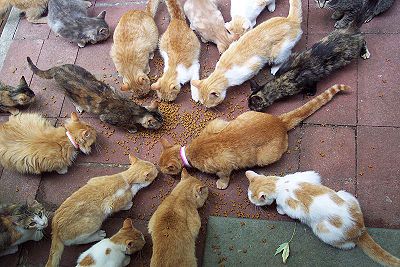
Cat Increased Appetite
Veterinarian Reviewed on June 22, 2012 by Dr. Janice Huntingford
Cat Increased Appetite
Signs and Symptoms
The medical name for an increased appetite in cats is polyphagia. When a cat suddenly develops a ravenous appetite, there can be several underlying conditions causing the increased food volume. A cat owner normally knows how much their cat consumes each day, when they begin begging for more, it may be time to head to the veterinarian.
Ketoacidosis (diabetes) in Cats
Some cats can develop Cat Diabetes and it is an extremely serious and life-threatening condition if left untreated. Just like people with diabetes, the cat’s body lacks the needed insulin that its body is not making. Some of the causes for cat diabetes is obesity, Cat Stress And Anxiety, surgery, and idiopathic where there is no apparent reason. Symptoms to look for include increased hunger, Cat Loss of Weight, increased thirst, Cat Vomiting, Cat Diarrhea, and Cat Lethargy.
It is vital to get the cat displaying any of the symptoms to a veterinarian in order to diagnose the disease and begin treatment. Diagnosis includes blood tests, urinalysis, and abdominal x-ray. Treatment often depends on the severity of the diabetes. Some cats respond well to a shorter course of insulin, while others have to be injected (by their owners) with insulin the rest of their lives.
Cushing’s Disease in Cats
Cushing’s syndrome or hyperadrenocorticism affects the endocrine that causes excessive cortical in the adrenal gland. It is not hugely common in cats, but when it strikes, it is normally around middle age and elderly felines. Causes for Cat Cushings Disease include iatrogenic Cushing’s, which is caused from too much cortisol a veterinarian administered for other conditions. Adrenal tumors are another cause of Cushing’s in cats and finally pituitary tumors can cause a cat to develop Cushing’s. Symptoms include increased appetite, increased thirst, increased urination, Cat Swollen Abdomen, hair loss, and lethargy.
Treatment depends on the cause. If corticosteroids are the cause, then a gradual tapering off of the drug, will normally improve the cat’s overall health. Drug therapy has not shown to be effective in cats, as it has when dogs develop Cushing’s disease. Lastly, removing the tumor or the adrenal glands can reduce the symptoms.
Feline Hyperthyroidism
Cats can develop the disease when the thyroid glands produce too much of the hormones, T3 and T4. Many times, the disease in cats is due to an adenoma or a tumor (benign) attached to one or both thyroid lobes. Symptoms include increased appetite, weight loss, increased thirst, increased urination, diarrhea, vomiting, behavioral changes (overgrooming, Cat Aggression, bald patches, nervousness), poor coat, and weakness. It is not necessary for the cat to display all the symptoms to be diagnosed with the disease.
Treatment options include medications to control the disease, removal of an enlarge thyroid, and radioactive iodine treatment. Most cats will begin on a drug therapy treatment as a first line of defense to see how they react.
Conclusion
It is vital cat owners watch their cat’s behavior when it comes to eating and drinking because a serious underlying condition may be developing. When a cat’s appetite suddenly increases for no apparent reason, it is time to take him or her to the veterinarian for a complete physical.
Sign up for our newsletter and receive more articles and the latest pet health updates and special offers.
Our Expert
 Dr. Janice Huntingford
Dr. Janice HuntingfordJanice Huntingford, DVM, has been in veterinary practice for over 30 years and has founded two veterinary clinics since receiving her Doctor of Veterinary Medicine at the Ontario Veterinary College, University of Guelph. She has studied extensively in both conventional and holistic modalities. Ask Dr. Jan

